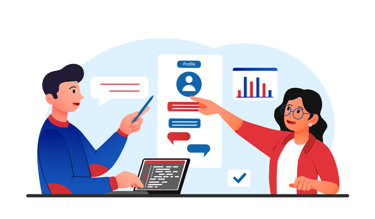How To Create And Use A Customer Persona To Get Results
By Adam Lofquist, Founder and CEO of The Lofquist Group

Editor’s note: This is part 3 of a 3-part series on Customer Persona. This explores how to create a customer persona and apply it to your B2B marketing and sales operations. If you missed part 1 or 2, you can read them here: Why You Need Customer Personas and Characteristics of a Customer Persona.
When creating your customer persona there are two main camps that organizations fall into. Those that have customers and those do not have customers or at least very few.
If you fall into the group with customers that is great, but it still does not mean you are finished, in fact it could be the recipe for disaster. The reason being is that you may have a lot of customers but a lot of personas as well, so when you try to market to all of them, you spread your budget too thin, and you lose money. It does not need to be this way.
You can get started on a solution by sending out a simple one question survey, asking your customers, how would their business be impacted if you shut down today? One, no change at all, and ten, they would go out of business as well. Focus on those that answered between 7 – 10. These are the customers that you can help the most.
Here are the ways that you can uncover what they have in common. Look at your CRM, talk to your customer success team and sales team. From an organizational level, identify things like the size of the companies in terms of revenue and employees, the industries they are in, market share, and other topics. For their role, focus on information around title, seniority, industry, experience, and other similar areas. Once you have identified that, go online, and start doing some research.
Who are the influencers for this customer persona, both in terms of people and other organizations? What is happening in their industry? What are they talking about online? What social media sites are they on and what are they talking about on those sites?
Don’t stop there, speak with them. There are two main ways that you will do this. The first is by using surveys. Surveys are a great way to build a wealth of quantitative data. Things like demographics, geographics, sources of information, influencers, and priorities. The second way is by using interviews. Interviews are a great way to gain qualitative information, to dig deeper and uncover hidden insights from what you learned with the survey.
The key is to assemble all this information and find similarities between your customers to build an effective customer persona. There will be some outliers and that is okay, do not try to make them fit right away because it will dilute the power of your persona.
If you are just starting out and have no customers here is what you can do. Frist identify the group of people you want to help with your new business, product set or service. Once you have done that, go out and talk to them and see if they also see the same problem or opportunity you do. You will want to start with a wide net in terms of who you talk to as you do not want to assume you can help a specific role or organization. Focusing on learning rather than being right or making a sale is the key to doing it right.
Once you have identified a group of twenty potential customers who see the same problem or opportunity as you, start to uncover what they have in common. Again, there are two main ways that you will do this. The first is by using surveys to build a library of quantitative data. Things like demographics, geographics, sources of information, influencers, and priorities. The second way is by using interviews. Interviews are the best way to gain qualitative information, that goes deeper and uncovers hidden insights that build on the survey data.
There are a couple of important things to remember. First is that none of this is really final, it will be evolving along with your customers. so be okay with being wrong. Another is that you can have more than one customer persona, but each will take separate marketing and advertising. Do not try to mix them.
But how do you use a customer persona effectively?
The first thing you need to do is share it with everyone in your organization. Do not have it in a binder collecting dust. Make sure you remind everyone in the organization why you have it, in a nice way, so they understand the value of it.
When it comes to marketing, use your customer persona to understand where you should be doing your marketing and advertising from your own website to trade shows and social media. Where are the people in your customer persona looking for information?
Use your customer persona to create marketing and advertising. What are the content topics the people in your customer persona want to know about? What are the issues they are struggling with or opportunities they want to capitalize on? How can you solve their objections and hang ups before they even talk to you? Highlight how your solution is better than their current solution.
Think about those who influence the process, from whom are the people that they need to get approval? Who are the people that will be using your product or service? Who are the people that will be against “hiring” your organization? How can you help this process be easier? How can you create marketing content that will reduce friction and get others to buy in?
When you create your customer persona, keep it simple in terms of the software or source you use. Way too many organizations try to make it fancy and spend more time designing how it looks rather than building a useful tool. With my clients I use a simple Microsoft Published template and it works.
Remember, you want your customer persona to help you create compelling marketing content and share it with everyone so they know how to talk about your company and what will engage your customers.
About the Author

Prior to starting The Lofquist Group, Adam worked at a number of startups and small to medium sized businesses where he helped them identify growth opportunities and then developed and executed plans that reached those opportunities. He also has worked with a number of non-profit organizations helping them grow their programs and have a greater impact on their clients and community.
Adam is driven by his ability to help people and organizations grow. He earned his business degree from the University of Wisconsin-Milwaukee where he majored in Marketing and Finance. In his free time, he likes to run, bike, and travel.
The Lofquist Group helps startups with revenue, validate the value proposition that will help their business scale. We help you leverage the actions of your target market not just what they say to make more informed decisions on how to market your startup.
